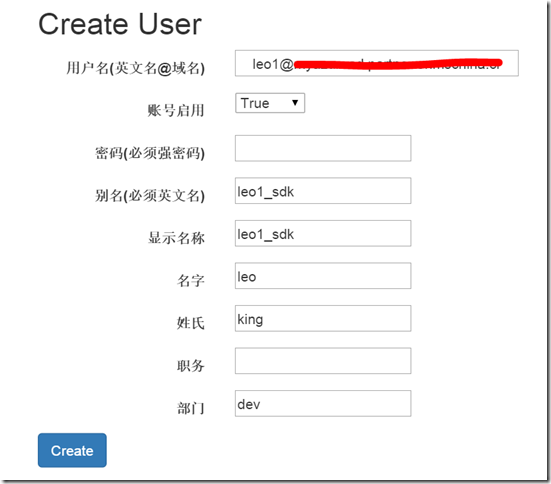3.2 Create创建用户
[HttpPost, Authorize] public async Task<ActionResult> Create( [Bind(Include = "UserPrincipalName,AccountEnabled,PasswordProfile,MailNickname,DisplayName,GivenName,Surname,JobTitle,Department")] User user) { ActiveDirectoryClient client = null; try { client = AuthenticationHelper.GetActiveDirectoryClient(); await client.Users.AddUserAsync(user); } catch (Exception e) { if (e.Message == "Authorization Required.") { HttpContext.GetOwinContext().Authentication.Challenge(OpenIdConnectAuthenticationDefaults.AuthenticationType); } return View(); } return RedirectToAction("Index"); }
Create的代码同样很清晰,采用了Bind Include简化了View的表单提交。对应的View的代码如下
@model Microsoft.Azure.ActiveDirectory.GraphClient.User @{ ViewBag.Title = "CreateUser"; } <h2>Create User</h2> @using (Html.BeginForm("Create", "AzureActiveDirectory", null, FormMethod.Post, new { @class = "form-horizontal" })) { @Html.ValidationSummary(true) <div class="form-group"> @Html.LabelFor(model => model.UserPrincipalName, "用户名(英文名@域名)", new { @class = "col-sm-2 control-label" }) <div class="col-sm-10"> @Html.TextBoxFor(model => model.UserPrincipalName) @Html.ValidationMessageFor(model => model.UserPrincipalName) </div> </div> <div class="form-group"> @Html.LabelFor(model => model.AccountEnabled, "账号启用", new { @class = "col-sm-2 control-label" }) <div class="col-sm-10"> @Html.EditorFor(model => model.AccountEnabled) @Html.ValidationMessageFor(model => model.AccountEnabled) </div> </div> <div class="form-group"> @Html.LabelFor(model => model.PasswordProfile.Password, "密码(必须强密码)", new { @class = "col-sm-2 control-label" }) <div class="col-sm-10"> @Html.TextBoxFor(model => model.PasswordProfile.Password) @Html.ValidationMessageFor(model => model.PasswordProfile.Password) </div> </div> <div class="form-group"> @Html.LabelFor(model => model.MailNickname, "别名(必须英文名)", new { @class = "col-sm-2 control-label" }) <div class="col-sm-10"> @Html.TextBoxFor(model => model.MailNickname) @Html.ValidationMessageFor(model => model.MailNickname) </div> </div> <div class="form-group"> @Html.LabelFor(model => model.DisplayName, "显示名称", new { @class = "col-sm-2 control-label" }) <div class="col-sm-10"> @Html.TextBoxFor(model => model.DisplayName) @Html.ValidationMessageFor(model => model.DisplayName) </div> </div> <div class="form-group"> @Html.LabelFor(model => model.GivenName, "名字", new { @class = "col-sm-2 control-label" }) <div class="col-sm-10"> @Html.TextBoxFor(model => model.GivenName) @Html.ValidationMessageFor(model => model.GivenName) </div> </div> <div class="form-group"> @Html.LabelFor(model => model.Surname, "姓氏", new { @class = "col-sm-2 control-label" }) <div class="col-sm-10"> @Html.TextBoxFor(model => model.Surname) @Html.ValidationMessageFor(model => model.Surname) </div> </div> <div class="form-group"> @Html.LabelFor(model => model.JobTitle, "职务", new { @class = "col-sm-2 control-label" }) <div class="col-sm-10"> @Html.TextBoxFor(model => model.JobTitle) @Html.ValidationMessageFor(model => model.JobTitle) </div> </div> <div class="form-group"> @Html.LabelFor(model => model.Department, "部门", new { @class = "col-sm-2 control-label" }) <div class="col-sm-10"> @Html.TextBoxFor(model => model.Department) @Html.ValidationMessageFor(model => model.Department) </div> </div> <p> <input type="submit" value="Create" class="btn btn-primary" /> </p> }
执行后的结果为
创建成功跳转到Index页面
为了让大家清楚的理解User属性对应的Azure门户管理上的提示,我在View中比较详细的做了说明,下表可以更清晰的看到对应
|
属性名 |
门户对应 |
要求 |
|
UserPrincipalName |
用户名 |
英文名@域名 |
|
AccountEnabled |
账号状态 |
|
|
Password |
密码 |
必须强密码 |
|
MailNickname |
别名 |
必须英文名 |
|
DisplayName |
显示名称 |
|
|
GivenName |
名字 |
|
|
Surname |
姓氏 |
|
|
JobTitle |
职务 |
|
|
Department |
部门 |
|
|
StreetAddress |
街道地址 |
|
|
City |
城市 |
|
|
State |
省/自治区/直辖市 |
|
|
Country |
国家或地区 |
|
|
PhysicalDeliveryOfficeName |
办公室号码 |
|
|
TelephoneNumber |
办公电话 |
|
|
PostalCode |
邮政编码 |

